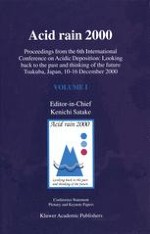2001 | OriginalPaper | Chapter
Long-Term Ecological Effects of Liming — the Iselaw Programme
Authors : Magnus Appelberg, Torbjörn Svenson
Published in: Acid rain 2000
Publisher: Springer Netherlands
Included in: Professional Book Archive
Activate our intelligent search to find suitable subject content or patents.
Select sections of text to find matching patents with Artificial Intelligence. powered by
Select sections of text to find additional relevant content using AI-assisted search. powered by
The Swedish liming programme was initiated in 1977 to counteract the effects of anthropogenic acidification on aquatic ecosystems until the acid deposition has been reduced. Ecosystem development in limed waters has been followed since 1989 in a programme for integrated studies of the effects of liming acidified waters (ISELAW). The main objectives are to assess a) the long-term ecological effects of liming, b) to what extent ecosystems recover to a pre-acidification state, and c) to elucidate possible detrimental effects of lime treatment. The programme comprises monitoring of water chemistry, phyto- and Zooplankton, vegetation, ben-thic invertebrates and fish in 13 limed and 5 non-limed lakes, and 12 limed and 10 non-limed streams. Paleolimnological studies are performed to reveal pre-acidification lake history. The results show that lime treatment detoxifies the water, although chemical and biological development varies among and within sites. In general the long-term changes are small compared to the initial changes associated with first treatment. Water chemical changes over time are reflected as reduced sulfur concentrations and increased nitrogen concentrations. Treated ecosystems seem not to recover fully to the situation before acidification, and due to re-colonization failure, several species are lacking in the limed waters.
